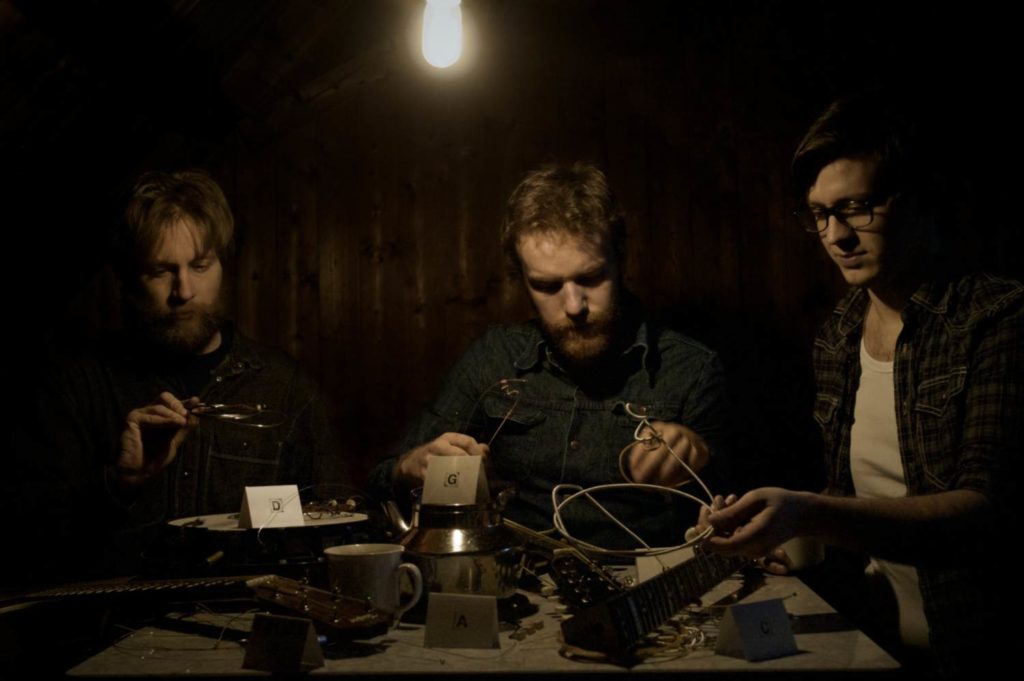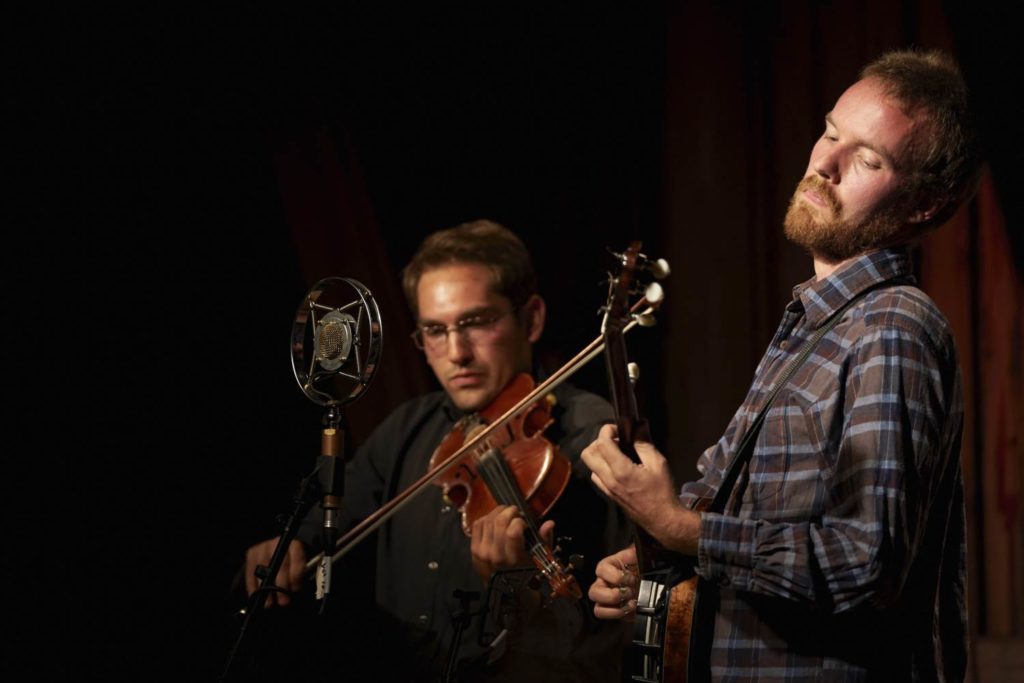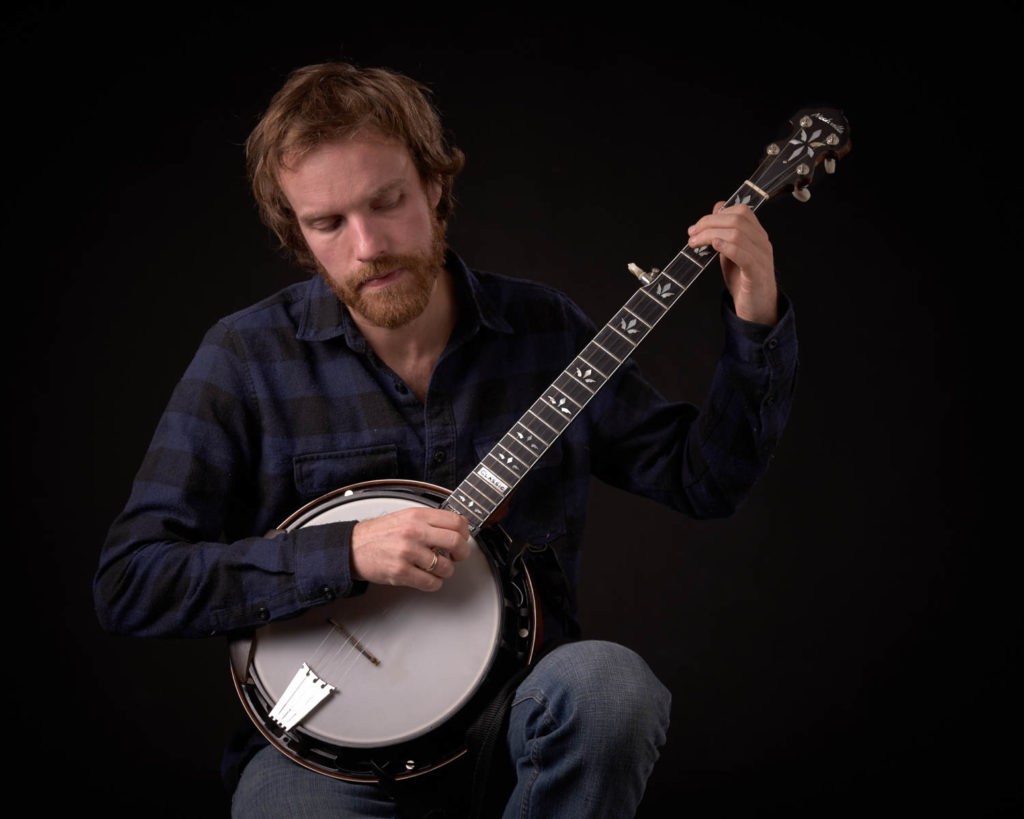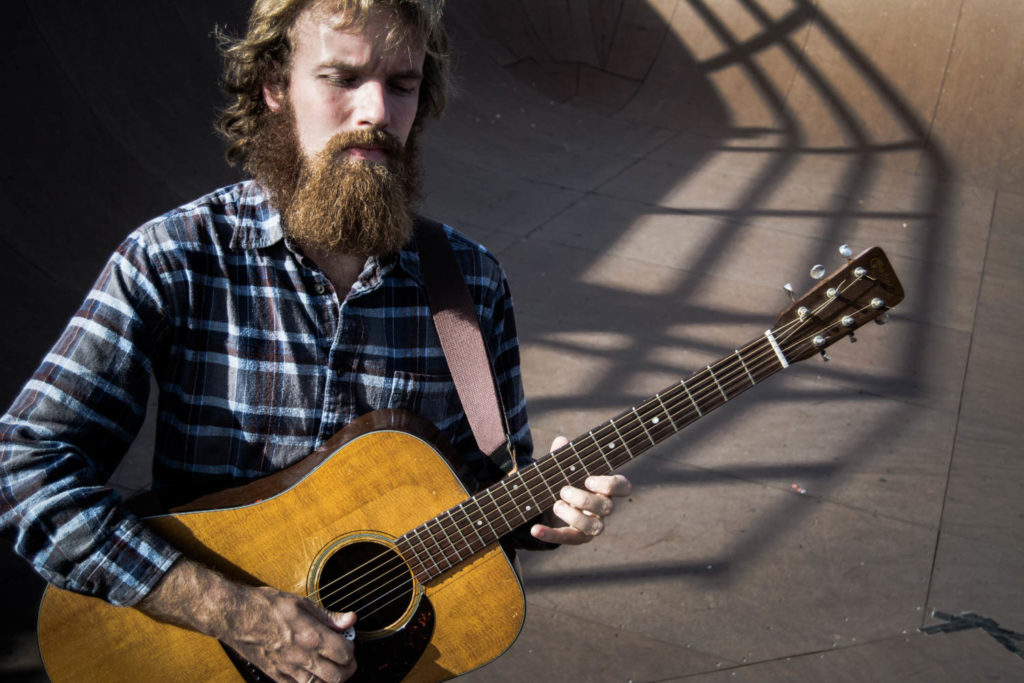I have always wanted to visit Norway. Ever since reading about it’s top ranking spot in the 2017 World Happiness Report I’ve had the “itch” to check it out. Little did I know that Norway also had a plethora of bluegrass musicians! In addition to Thorbjørn Olsen and Mikael Jonassen, Mr. Magnus Wiik joins the Norwegian AcoustiCult interviewees. Thanks for joining me and taking time to do this Magnus. Tell our readers a little bit about yourself.
Thanks for having me! My name is Magnus Wiik, I’m a musician from Trondheim, currently living out in Rauland, the rural south of Norway. I started out as a guitar player and branched out to other instruments as well, and now I do just as much work playing banjo, mandolin, fiddle and dobro. I think of myself being somewhere between bluegrass and jazz/improvised music, and I also have strong interests for Irish and Norwegian music. I have a bunch of bands I play with, Open String Department, Haley’s Comet, Ellestad Wiik Duo, as well as a bunch of free lance work. On a side note I do some teaching in the University of South Norway, and started a 15 credit course in bluegrass last fall that I’ve just completed the first year of.
JED: You *created* a full semester’s worth of college courses on Bluegrass music?
Not a full semester, it would be half a semester. A full year of studies here would be 60 credits, so it’s 1/4th of a full year and it runs through the whole year. Long story short, it’s created for both students of Norwegian folk music and blues, and is both practical and theoretical. It’s been interesting and rewarding to try, I’ll be revising the “curriculum” for the fall and suspect it’ll be a bunch of revisions through the first few years (and hopefully expand as well).
JED: That is awesome man! Bravo for taking the time to construct those courses. There is a lot of unseen effort and work that goes into creating an educational and instructional program like that. Tell us a little bit about your beginnings. Your origin story, so to speak. How did you get into music, and what made you choose this path over others?

I had been playing guitar since I was a kid, and got heavily into it in my teens. Back then I loved metal, which essentially developed into a love for anything fast on guitar. This eventually led me onto fusion and eventually jazz in high school, where I met some musicians who are today among my best friends and longtime collaborators. I’m from Trondheim in Norway, which has a great jazz department that I really became aware of in high school. A lot of the musicians I discovered back then had gone there, and it became my dream to study there.
I also discovered folk music in early high school, I got really into Irish music and eventually bluegrass also. At this point I thought this was never going to be something I played but just something I enjoyed listening to as I was pretty determined to be a jazz musician, whatever that is. I eventually started dabbling in trying to play some Irish guitar, and later I bought a banjo and a dobro. For me then the lines between Irish and American music was pretty blurred.
JED: Who were some of the first “bluegrass” musicians or albums you remember being exposed to? Who showed them to you?
I first got into AKUS, Emmylou Harris and Dixie Chicks at about the same time. There was a band called Cricket Club (with an amazing fiddler called Ola Kvernberg) that I went to see a few times. They played music from said artists repertoire and I took their setlists after the shows some times. I searched for the songs on the internet and bought the albums I found them on.
Two-thousand and seven was a pretty defining year, when I eventually got into the jazz department in Trondheim. That year I also had the chance to go to Banff in Canada, where every May there is a great jazz workshop spanning three weeks. I met several people I would collaborate with over the next years there, but my main epiphany was meeting some Irish musicians. I didn’t really have a clue about playing Irish music then, but loved to try. There was a sax/clarinet player, Matt Berrill and his sister Naomi Berrill who showed me a lot, and I was blown away by how well they could play guitar and fiddle just like it was no big thing. So that gave me a gateway to going to Ireland and checking it out for myself, which I did for the first time in 2008 and have done a lot since.
Following Trondheim, I spent a year in Copenhagen (09-10) and years in Oslo (10-18) doing a masters degree in jazz and improvised music, but as I see it bluegrass has a lot of potential in that direction too. So that’s what I was exploring mostly. I didn’t have much of a clue about playing bluegrass until I came to Copenhagen in 09/10 and started frequenting a jam hosted by Arne Sørensen. He had a lot of records and would every week give me a bunch of albums I needed to check out. I didn’t know much about fiddle tunes and repertoire back then so that really opened some doors for me.

JED: What are some of your favorite albums, and how do they influence your work?
Solas – Solas: Got me heavily into Irish music, and changed my life for that. Actually all the three first Solas-albums are pretty much equally fantastic. I guess I discovered them in 2002, and there weren’t until many years later that I started trying to play that music. I don’t listen much to Irish bands now, some of my favorite Irish music these days are solo recordings such as MacDara O Raghallaigh’s magnificent Ego Trip album. But I would never have dove into this rabbit hole if it weren’t for Solas. I’ve had the chance to play guitar behind some amazing Irish musicians (Gerry O’Connor, Tony O’Connell and Ronan Ryan to name some), which is one way this has influenced my work. Though I’ve tried to play Irish longer than bluegrass, bluegrass was easier for me to adapt to. But I think my approach to playing guitar behind fiddlers is a lot inspired by John Doyle especially, and the whole vibe of Solas. This is something I’ve tried, with various degrees of success, to adapt to Norwegian music.
Brad Mehldau Trio – Art of The Trio Vol. 5: Has whatever I would call the blueprint for interplay in a trio setting. He was a huge influence on my guitar playing, and this album is my favorite. It’s hard to pick one jazz-album but if you go through the Art of The Trio-series it’s very interesting to see how they’ve developed the interplay. I love the whole series. I got into Brad Mehldau in 2003, that was about when my taste in music started picking up some class. I’d been listening to a lot of hairy metal with shred guitar, leading me to some pretty questionable jazz fusion with shred guitar, leading me into Michael Brecker who became an obsession for a while, until Mehldau took over. I transcribed a lot of Mehldau in school and had a trio that played mostly Mehldau-tunes and then some tunes inspired by him for a while. Playing jazz guitar I’ve generally been a lot more interested in pianists than guitarists. On a piano you really have a huge range. You can play dense chords and do a lot with your left hand to fill out the sonic space of your melodic lines. The synergy between the left and right hand is probably what intrigues me, and with Mehldau you sometimes have two different things going. Although you can’t really do everything a piano can on a guitar I love to try and adapt the ideas and perhaps adapt a pianists approach a little. These days I’m on paternity leave and check out a lot of music. I just discovered Marc Copland, a name I haven’t checked out properly before now. His tonality really speaks to me. I haven’t released much jazz music, but there is an album from 2010 called Yearning by the group Aphrodisiac where I think some of my playing is pretty inspired by pianists. Also, a few years ago Steady Bear by Erik Løkra Volunteer Quartet came out and that might have some of this stuff. I’ve also worked in duo with a great Canadian bassist (and fiddler) Robert Alan Mackie, we’ve got some tracks on YouTube where we blur the lines between jazz and grass a little.
Chris Thile – How to grow a woman: I came back from Banff psyched about studying jazz in Trondheim, then all of a sudden I got this album. It might have been my most shocking musical experience putting it on. I didn’t know much about this exploratory bluegrass and it made me question what I really wanted to do with music! I’ve had my eye on The Punch Brothers and the scene around those guys ever since.
Christian Wallumrød Ensemble – The Zoo Is Far: A great album, full of great ideas. Wallumrød was certainly one of my biggest inspirations for composing music for a while. I had some lessons with him doing my masters in Oslo, where I wanted to see if I could understand how he goes about composing. I also envisioned myself being this kind of band leader from the mid 2000’s, this kind of chamber music approach. In the beginning I was thinking that Open String Department would somehow be more similar to Christian’s ensemble, and I worked a little with two classically trained but very diverse string players on violin and cello. It’s a world I seem to come back to every now and then. He has definitely inspired music I’ve composed for both Aphrodisiac and (a never released group) Zampano with the French saxophonist Alexandra Grimal.
Miles Davis – My Funny Valentine: Maybe my favorite Miles-album, it’s got such an incredible nerve through it. I had a big Miles-kick in high school, starting with Bitches Brew and then going backwards. It’s hard to pick out one album, and there are a lot of great albums with his quintet (later with Wayne Shorter instead of George Coleman who is on this album) that are so happening! I think the interplay with Herbie Hancock and Tony Williams is what made this quintet so great, it’s a little like they were the first explorers of this new jazz. That might be a stupid way to say it, there was a lot of adventurous music before this album as well of course. When I hear this I just get a feeling that they were paving a new way, and making new things out of an existing tradition, pushing the envelope. It seems like you can hear it, and that might be why it feels so vibrant.
Art of the Gadulka (various): An incredible collection of gadulka-music, mostly played by Athanas Valchev. There’s a lot of this music that is incredible but has a very cheesy aesthetic, but this album is almost only gadulka and drum. Fantastic stuff! I learned a lot of these tunes, though I can’t play this tradition at all. When I did my masters I tried learning about improvisation in different traditions, and I had some lessons with a great accordionist called Jovan Pavlovic where I learned some tunes similar to those on this album and worked on how he would approach improvising on them. It was really interesting to see how you would make up little themes on a groove and develop them with variations, definitely with similarities to bluegrass but also very different. As another part of my masters I went to India to learn about konnakol, their approach to rhythm. Both Indian and “Balkan” are traditions I wanted to investigate a little to get some more tools in my toolbox so to speak. Unlikely traditions I’ll ever really play, but I love listening to. On a side note I’ve used this album for teaching odd meters, you’ll find pedagogical tunes in 5, 7, 9, 11, 13 and 22 on this!

JED: Which part of your music career do you enjoy the most – live performance, recording, writing, etc.?
These days I don’t get to enjoy live performance much at all, as I’m sure is the case with most musicians [due to the CCP virus restrictions]. A mix of those three are essential, but I like performing the most for sure. I love playing concerts, but I can also love playing weddings and functions like that as long as the vibe is good. Sometimes I love that more, as it gives me the chance to mash bluegrass for hours on end, whereas a concert is over so fast. If there isn’t a jam afterwards.
JED: That is one thing that is nice about playing music for events that aren’t concert settings; getting to play without the pressure of an ultra-attentive audience. Ya know like if you wanna play 4 times through Big Mon and go “out on a limb” on a solo you can, whereas in a concert setting you might be more inclined to stick to something you know. A musician needs that every now and again – it’s low pressure.
Yeah, exactly! I love writing and recording too, but it usually correlates to performing. So when it is a down time, like now, it can be hard to find a direction for what to do. I also have two small children at home, which demand quite a bit of energy.
JED: Oh goodness so you’re a dad as well?
Yep, a boy that is 9 months (born on Bill Monroe’s birthday, just sayin’!) and a girl that’s 3 and a half years. Norway is pretty good for musicians compared to many other countries, these days I have paternity leave for more than three months getting government compensation for taking time off freelance work! Daycare is affordable too, thank God. So my wife and I live out on the countryside a couple of hours west of Oslo, where we bought a house last year. We teach at the university here where you can study Norwegian folk music (and now also bluegrass). She is Canadian and plays Norwegian hardanger fiddle, and knows a lot more about Norwegian folk music than me. We’re not entirely on the same page as to what our children are going to be playing (I want to get our daughter started on bass), but we’ll get there! Parenting is pretty full on these days, and with the daycare being closed due to covid for some weeks it’s been a little like living in a bubble. Even if we didn’t get much done professionally and the frustrations that can cause it was actually pretty cool for the kids and the family, our kids got a lot of time together as our oldest is usually in daycare 5 days a week.
Living out in the countryside has a lot of perks, and I really like many aspects of it. To stay sane it’s imperative for me to be on the road and touching base with the scene in Oslo. It’s been about three months now, so you can imagine where my sanity levels are at!
JED: That is awesome that you’re able to spend so much time with your family. That being said, I can understand the feeling of needing to get out a bit! Who are three musicians that you think are underrated or deserve more notoriety for their art?
Stian Carstensen might be off the top of my head, though he has notoriety for sure here. I heard him first with his band Farmers Market back in 2001, and it was a major inspiration for me then. Those guys all studied in Trondheim, so I think that was when I decided that I had to do that too. Stian plays pretty much anything really well, his main instrument being accordion. I’ve been blown away by most of what he does, maybe especially pedal steel the last years. He has a trio called Gammalgrass too, and I think if you asked a lot of people in Norway (me included) to put the three most badass musicians into a trio this is what you’d get!
Jonas Cambien is a pianist from Belgium who moved to Norway ten or so years ago. I’ve never played with him, but every time I’ve heard him the last maybe 6 years or so I’ve been blown away. He’s really got something of his own, a strong agenda as a pianist, composer and band leader.
Jordan Tice, while probably not exactly unknown to your following I’d say he deserves all the notoriety he can get! I was blown away by his debut album, and have been following him on and off since then. I saw some of his home routes stream now, and I think he’s taking some really interesting paths as a musician.
JED: Tell us a little bit about your current rig – what does your “rig” consist of? What instrument(s) do you play, pedals, mics, etc.?
I have my main acoustic guitar, a Martin D18 from 1963. In the guitar department I also have a G&L tele, Ibanez Artstar, some unspeakable 80s guitars and a Martin from 53, smaller body that I use a bit as well.
JED: Tell me more about the Martin from 53 – is it like a 000 body or something?
Yep! I don’t know much about it apart from that, it could do with a neck reset, but it sounds really incredible so I don’t think I’ll dare to do anything with it.
JED: Right; “if it ain’t broke don’t fix it.”
I play a Nechville Classic Deluxe banjo, a Rayco Dobro, a Gibson A style mandolin from the 30s (which I hope to swap for something else down the line), my wife’s 5 string fiddle modified by Silakowski. I’ve got a crappy bass and a crappy cello, a fantastic Sam Murray Irish flute, a MSA pedal steel that I’ll get around to learning when the kids are a little older, a nice Rhodes, a few synths, some drums that I just bought which I have to pick up in Oslo and a nice harmonium that I bought hours ago for next to nothing! As you can probably tell I’m not a tech head. I’ve got a couple of lindell audio and midas preamps, and now two SA-87 microphones which have elevated my recording possibilities a lot.
JED: You have a lot of instruments man! If you were given an unlimited budget for an album production to record your dream album, what would it look like?
I would probably spend most of the money freeing up time for the musicians to justify putting down a lot of time and effort into rehearsing and working out material. It might be an album with my group Open String Department, with whom I have a really good report and interplay featuring guests.
JED: Who are some of the guests you’d want to have on it?
Right now I’ve had in mind to do something with a variety of guests in Norway, people that aren’t necessarily in the bluegrass world at all. Who I’ve had in mind is Harpreet Bansal (incredible violinist), Per-Oddvar Johansen (killer drummer), Jovan Pavlovic (incredible accordionist) and Jan Beitohaugen Granli (amazing hardanger fiddler). It would also be very cool to do something in the States with American musicians. We actually had Mike Barnett on a track on an album we did years ago (with a band called Julie & The New Favorites), and I love his style. It’d also be really cool to do something with Simon Chrisman as well. There are a ton more players I’d love to work with, so if I start naming more I’d probably fill up the next few pages.
A good studio and as much time to record that we need goes without saying, but I think I’d spend the most on doing the prep for it.
I would also love to make a record with some of my favorite musicians in the USA as well. On a side note to this, as part of my masters degree I had funding to do a project in the USA with Jake Jolliff and Wes Corbett. We spent one day rehearsing and two days recording, and at that time I couldn’t really play bluegrass guitar at all! Since I played a lot of banjo and mandolin, I sort of assumed I could do it, but that was a hard earned lesson. Since then I’ve practised, and I’d love to do a more ambitious version of something like this with more prep time (and better guitar playing!) some time!
JED: So you flew into Nashville for a few days to record this? Where did you record at?
This was when they were in Boston back in 2013. We did one day in Dirty Water Studios in Charlestown (I think) and one in Wellspring (well outside of town). I was a little late booking the studio so it ended up being two different ones.
JED: What is your favorite album or recording that you’ve made to date?
I’m really happy with Open String Department – Americanarchy, which came out in January. It’s probably my favorite so far.

JED: What are you currently working on?
I’m learning to sing, and have two upcoming albums coming out where the only thing left to do is add vocals. I’m trying to become a better singer and what little time I have to practise I devote to that. The albums are called Rad and Trad, the first is my original music and the second is my idea of trad music; some trad songs and tunes, some Black Sabbath and Elliott Smith twisted a little. I’ve done all the playing and recording on these, and hope to be ready to do the singing soon! Everything besides the vocals on these albums were done last summer, then I had a son and life got busy.
I’m also writing some more music for me, I figure I should start on the third album now seeing that it takes a while! I’ve also been working on some music for Haley’s Comet, a duo I have with NC fiddler Meade Richter. We’ve had the chance to play a lot over the years, and I’ve learned so much from him about bluegrass.
JED: Well Magnus it sounds like you have plenty to keep you busy! Thank you so much for taking the time to talk with us a bit and tell us about your life and music.
Thanks a lot for having me, it’s interesting and fun to get a chance to talk about whatever’s shaped me as a musician!
Stay in touch with the latest from Mr. Wiik on his YouTube channel, Instagram, and website. Featured article photo by Hans Martin Austestad.

